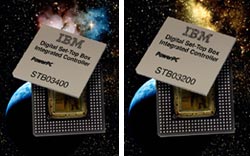IBM Upgrades Set-Top Chip
 IBM has rolled out the next generation of its single chip set top box design, adding speed and functionality.
IBM has rolled out the next generation of its single chip set top box design, adding speed and functionality.The three new chips are based on IBM's "system on a chip" design that targets advanced digital set-top boxes delivering Web access, e-commerce, home banking and information retrieval. The chips represent an advance on IBM's previous STB single-chip platform, the STB01000 series introduced a year ago.
Based on either the IBM PowerPC 405 or 401 processors, the new chips include an MPEG-2 audio/video decoder, a memory interface subsystem and a wide range of peripheral interfaces. The STB032xx and the STB034xx chips are based on the PowerPC 405 and feature high-speed operation at 108 MHz or 162 MHz, with a 16-KB instruction cache and an 8-KB data cache.
IBM claims the STB034xx provides the fastest single-chip speeds in the STB industry, giving developers additional performance and programmability for new applications. For traditional applications, the STB021xx chip based on the PowerPC 401 and features operation at 54MHz. In addition to the STB Power PC chips, IBM has introduced a companion audio/video/transport decoder chip for emerging applications, including dual channel (picture-in-picture) and digital video recording.
IBM officials claim the new chips bring enough computing power to set-tops to equal or surpass that of PCs only a year or two ago. "These chips will help fundamentally change the way movies, music and other digital entertainment is delivered to our homes, as well as the way we conduct personal business transactions," says Paul Belluz, director of digital video products, IBM microelectronics division.
Samsung is among the first customers for the new IBM chips. Customer samples of the STB Power PC 405 system-on-a-chip – and the companion audio/video/transport decoder – are expected to be available in May, with production volumes available in July. The new PowerPC 401 STB system-on-a-chip solutions will be available in the second half of 2000.
Edited by Tom Butts
